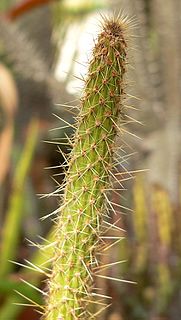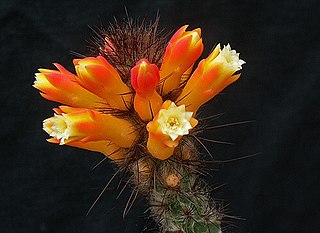
Leocereus bahiensis is a species of cactus and the only species of the genus Leocereus.

Brasiliopuntia is a genus in the cactus family, Cactaceae. It contains only one species, Brasiliopuntia brasiliensis.
Kalyptodoras bahiensis is the only species in the genus Kalyptodoras of the catfish family Doradidae. This species is endemic to Brazil where it is found in the Paraguaçu River in the northeast and reaches a length of 24.5 centimetres (9.6 in) SL.

Amblyseius is a large genus of predatory mites belonging to the family Phytoseiidae. Many members of this genus feed on other mites such as red spider mites, and also on thrips. Several species are popular as biological control agents to control these pests.
Cratylia bahiensis is a species of legume in the family Fabaceae. It is found only in Brazil.

Arrojadoa bahiensis is a species of plant in the family Cactaceae. It is endemic to Brazil. Its natural habitat is rocky areas.
Euplassa is a genus of flowering plants in the protea family.
Rollinia bahiensis is a species of plant in the Annonaceae family. It is endemic to Brazil. It is threatened by habitat loss.
Scherya is a genus of flowering plants in the daisy family, Asteraceae. The only known species is Scherya bahiensis, native to the State of Bahia in eastern Brazil.
Amblyseius americanus is a species of mite in the family Phytoseiidae.
Amblyseius ampullosus is a species of mite in the family Phytoseiidae.
Amblyseius andersoni is a species of mite in the family Phytoseiidae. It is found in Europe.
Amblyseius animos is a species of mite in the Phytoseiidae family. It was described by A.S. Khan, M. Afzal and Shamshad Akbar in 2000, and is known from Pakistan.
Amblyseius bellatulus Tseng is a species of mite in the Phytoseiidae family that is native to Taiwan. It was described by Tseng Yi-Hsiung in 1983. Following his retirement, Tseng's collection of more than 20 holotypes of Taiwanese phytoseiid fauna were lost. A. Bellatulus re-described in 2017 by a team from National Taiwan University led by Liao Jhih-Rong, who collected new specimens of phytoseiid mites from the original locale used by Tseng as well as other areas throughout Taiwan.
Amblyseius siddiqui is a species of mite in the family Phytoseiidae.
Typhlodromips swirskii, the Swirski mite, is a species of predatory mite in the family Phytoseiidae. It is used in biological pest control of western flower thrips in greenhouse or indoor grown crops.

Discocactus bahiensis is a species of Discocactus from Brazil.
Sebastiania bahiensis is a species of flowering plant in the family Euphorbiaceae. It was originally described as Gymnanthes bahiensisMüll.Arg in 1863. It is native to Bahia, Brazil.




